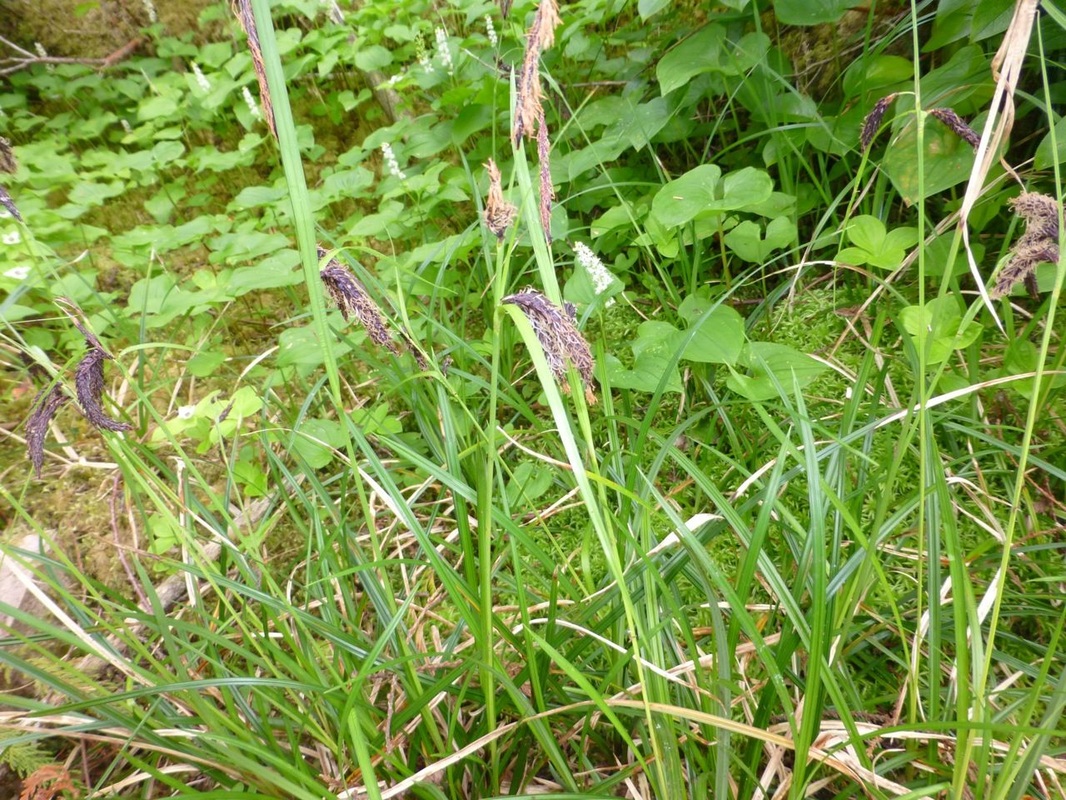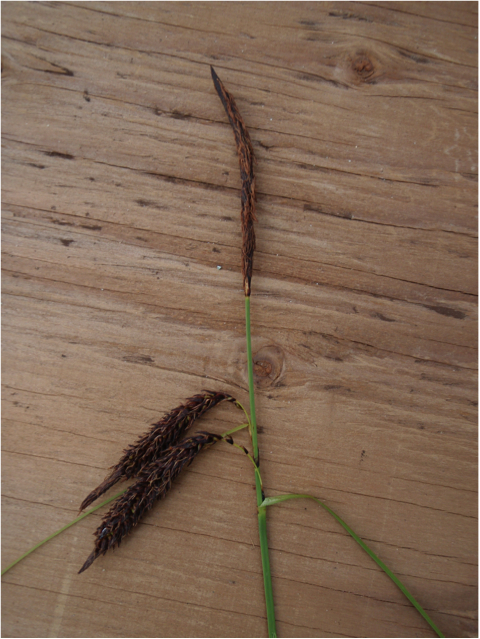Slough sedge • Carex obnupta
Identification
Slough sedge grows in dense tufts from long, creeping rhizomes. Its stiff stems are 60-150 cm tall and sheathed with shorter leaves. The leaves can be up to 1 cm wide, and have rolled edges. One to three male inflorescences grow at or near the end of the stem. The lower 2-4 spikes are female (bottom left photo), and either do not grow on stalks or droop down from short, upright stalks. The bract around the lowest spike(s) looks like a leaf, and is longer than the spikes. The yellow-green or brown perigynia (sacs covering reproductive parts and fruit) are shiny and plump.
Habitat & Range
Slough sedge grows in swamps, marshes, wet meadows and forests, and along streams. It is a common species at low elevations in coastal areas. Its west coast range stretches from Haida Gwaii and the adjacent BC coast to California.
Similar Species
Lyngby's sedge is similar but has dull perigynia and lower spikes on long, drooping stalks, versus slough sedge's shiniy perigynia and short-stalked or stalkless lower spikes. They are usually found in different habitats as well - Lyngby's sedge is predominantly found right along the coastline in areas such as tidal marshes and flats.
Human Uses
Slough sedge is a traditional basket material in multiple First Nations cultures.
Slough sedge grows in dense tufts from long, creeping rhizomes. Its stiff stems are 60-150 cm tall and sheathed with shorter leaves. The leaves can be up to 1 cm wide, and have rolled edges. One to three male inflorescences grow at or near the end of the stem. The lower 2-4 spikes are female (bottom left photo), and either do not grow on stalks or droop down from short, upright stalks. The bract around the lowest spike(s) looks like a leaf, and is longer than the spikes. The yellow-green or brown perigynia (sacs covering reproductive parts and fruit) are shiny and plump.
Habitat & Range
Slough sedge grows in swamps, marshes, wet meadows and forests, and along streams. It is a common species at low elevations in coastal areas. Its west coast range stretches from Haida Gwaii and the adjacent BC coast to California.
Similar Species
Lyngby's sedge is similar but has dull perigynia and lower spikes on long, drooping stalks, versus slough sedge's shiniy perigynia and short-stalked or stalkless lower spikes. They are usually found in different habitats as well - Lyngby's sedge is predominantly found right along the coastline in areas such as tidal marshes and flats.
Human Uses
Slough sedge is a traditional basket material in multiple First Nations cultures.
References
Carex obnupta L.H. Bailey. In Klinkenberg, Brian. (Ed.). E-Flora BC: Electronic Atlas of the Plants of British Columbia. Lab for Advanced Spatial Analysis, Department of Geography, University of British Columbia, Vancouver. Accessed 03/09/2013.
Pojar, J. and MacKinnon, A. (1994). Plants of Coastal British Columbia. Vancouver, BC: Lone Pine Publishing. P. 400.
Authors and editors of page
Kelly Fretwell and Brian Starzomski (2013).
Carex obnupta L.H. Bailey. In Klinkenberg, Brian. (Ed.). E-Flora BC: Electronic Atlas of the Plants of British Columbia. Lab for Advanced Spatial Analysis, Department of Geography, University of British Columbia, Vancouver. Accessed 03/09/2013.
Pojar, J. and MacKinnon, A. (1994). Plants of Coastal British Columbia. Vancouver, BC: Lone Pine Publishing. P. 400.
Authors and editors of page
Kelly Fretwell and Brian Starzomski (2013).






